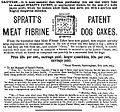Dog biscuit
Dog biscuit is a type of dog food specifically formulated and intended for consumption by dogs. These biscuits are often hard and dry. Dog biscuits are commonly used by dog owners for training purposes and as dietary supplements, contributing to the dog's oral health and nutrition.
History[edit]
The concept of the dog biscuit dates back to the mid-19th century when American electrician, James Spratt, went to London to sell lightning rods. After observing dogs being fed leftover biscuits from a ship, Spratt formulated the first dog biscuit: a mix of wheat meals, vegetables, beetroot, and beef blood. His biscuits were a hit among British country gentlemen who used them to reward their hunting dogs. This marked the beginning of the commercial dog food industry.
Ingredients[edit]
Modern dog biscuits are manufactured using a variety of ingredients to ensure they are nutritious and appealing to dogs. Common ingredients include:
- Meat and meat by-products
- Grains such as wheat, corn, and barley
- Vitamins and minerals
- Fats and oils
- Fibers for digestive health
Some high-quality dog biscuits may also contain supplements like glucosamine for joint health, omega-3 fatty acids for a healthy coat, and antioxidants for immune support.
Types[edit]
There are several types of dog biscuits available in the market, catering to different dietary needs and preferences:
- Puppy biscuits: Specially formulated for young dogs with additional nutrients to support growth.
- Senior dog biscuits: Lower in calories and easier to chew, addressing the dietary needs of older dogs.
- Dental biscuits: Designed to reduce plaque and tartar build-up, promoting oral health.
- Hypoallergenic biscuits: Made without common allergens like wheat, corn, and soy for dogs with food sensitivities.
Benefits[edit]
Dog biscuits offer several benefits beyond being a tasty treat for dogs. They can:
- Help with dog training and behavior modification as a form of positive reinforcement.
- Promote dental health by reducing tartar and plaque build-up.
- Provide essential nutrients and supplements that may be missing from the dog's main diet.
- Serve as a convenient way to feed dogs while traveling or on the go.
Considerations[edit]
When choosing dog biscuits, it's important to consider:
- The dog's age, size, and dietary needs.
- The quality of ingredients and the presence of any fillers or artificial additives.
- The calorie content, especially for dogs that are overweight or have a low activity level.
Conclusion[edit]
Dog biscuits are a versatile and beneficial addition to a dog's diet. Whether used for training, as a dietary supplement, or simply as a treat, choosing the right type of biscuit can contribute to a dog's overall health and well-being.
-
Dog biscuit
-
1867 ad for Spratt's dog food
-
1876 ad for Spratt's Patent Meat Fibrine Dog Cakes
-
Dog with treat
-
Maltoid milk-bone
Ad. Transform your life with W8MD's Budget GLP-1 injections from $75


W8MD offers a medical weight loss program to lose weight in Philadelphia. Our physician-supervised medical weight loss provides:
- Weight loss injections in NYC (generic and brand names):
- Zepbound / Mounjaro, Wegovy / Ozempic, Saxenda
- Most insurances accepted or discounted self-pay rates. We will obtain insurance prior authorizations if needed.
- Generic GLP1 weight loss injections from $75 for the starting dose.
- Also offer prescription weight loss medications including Phentermine, Qsymia, Diethylpropion, Contrave etc.
NYC weight loss doctor appointmentsNYC weight loss doctor appointments
Start your NYC weight loss journey today at our NYC medical weight loss and Philadelphia medical weight loss clinics.
- Call 718-946-5500 to lose weight in NYC or for medical weight loss in Philadelphia 215-676-2334.
- Tags:NYC medical weight loss, Philadelphia lose weight Zepbound NYC, Budget GLP1 weight loss injections, Wegovy Philadelphia, Wegovy NYC, Philadelphia medical weight loss, Brookly weight loss and Wegovy NYC
|
WikiMD's Wellness Encyclopedia |
| Let Food Be Thy Medicine Medicine Thy Food - Hippocrates |
Medical Disclaimer: WikiMD is not a substitute for professional medical advice. The information on WikiMD is provided as an information resource only, may be incorrect, outdated or misleading, and is not to be used or relied on for any diagnostic or treatment purposes. Please consult your health care provider before making any healthcare decisions or for guidance about a specific medical condition. WikiMD expressly disclaims responsibility, and shall have no liability, for any damages, loss, injury, or liability whatsoever suffered as a result of your reliance on the information contained in this site. By visiting this site you agree to the foregoing terms and conditions, which may from time to time be changed or supplemented by WikiMD. If you do not agree to the foregoing terms and conditions, you should not enter or use this site. See full disclaimer.
Credits:Most images are courtesy of Wikimedia commons, and templates, categories Wikipedia, licensed under CC BY SA or similar.
Translate this page: - East Asian
中文,
日本,
한국어,
South Asian
हिन्दी,
தமிழ்,
తెలుగు,
Urdu,
ಕನ್ನಡ,
Southeast Asian
Indonesian,
Vietnamese,
Thai,
မြန်မာဘာသာ,
বাংলা
European
español,
Deutsch,
français,
Greek,
português do Brasil,
polski,
română,
русский,
Nederlands,
norsk,
svenska,
suomi,
Italian
Middle Eastern & African
عربى,
Turkish,
Persian,
Hebrew,
Afrikaans,
isiZulu,
Kiswahili,
Other
Bulgarian,
Hungarian,
Czech,
Swedish,
മലയാളം,
मराठी,
ਪੰਜਾਬੀ,
ગુજરાતી,
Portuguese,
Ukrainian





